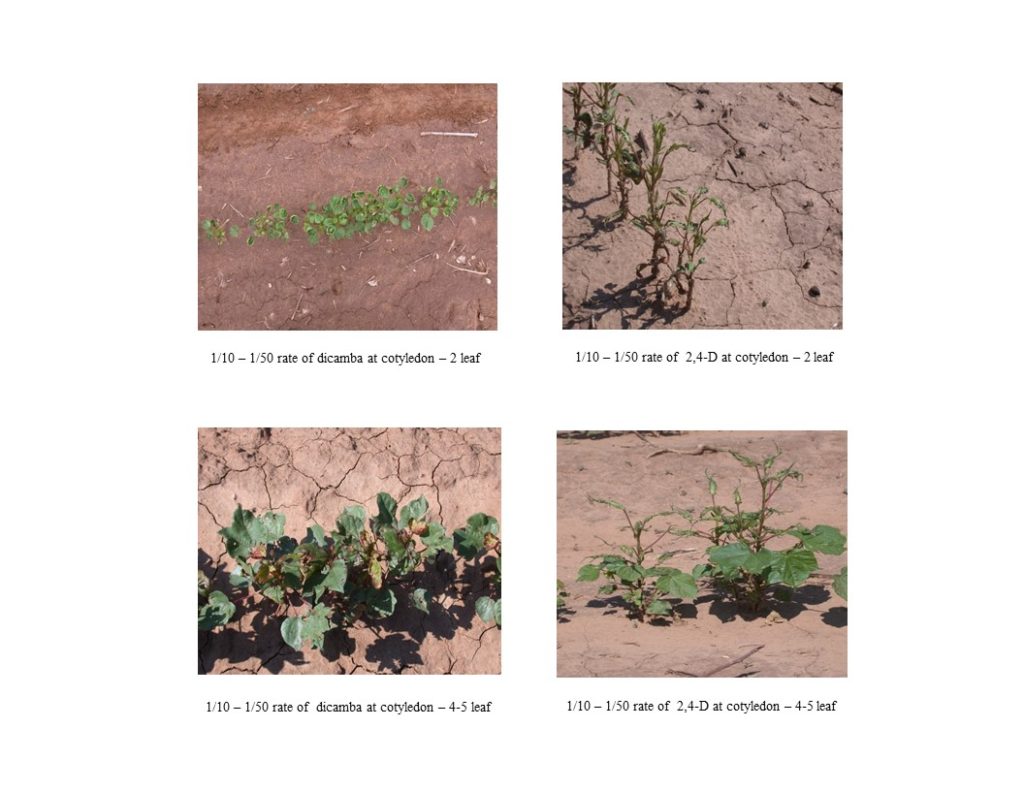by Seth Byrd – Extension Cotton Specialist – Lubbock, TX; Peter Dotray – Extension Weed Scientist – Lubbock, TX; Wayne Keeling – Research Cropping Systems and Weed Science – Lubbock, TX; Misha Manuchehri – Extension Weed Scientist (OSU) – Stillwater, OK; Josh McGinty – Extension Agronomist – Corpus Christi, TX; Gaylon Morgan – State Extension Cotton Specialist – College Station, TX
Cotton injury from herbicide drift and potential yield loss has been a hot topic recently, both among producers and in the popular press. It is important to note that this is a complex issue and a definite answer to “How much yield will I lose?” is difficult if not impossible to accurately predict. Previous studies evaluating sub-lethal (drift or tank contamination) rates of dicamba and 2,4-D have illustrated the complex relationship between visual injury and yield loss. Often, there is a poor relationship between the two (i.e. severe visual foliar injury results in minor to no yield loss, or vice versa) and many factors play a role in cotton’s yield response after exposure to these herbicides. Important factors include growth stage at time of exposure, rate/concentration of herbicide, degree of exposure, and environmental conditions after exposure.
A summary of previous research indicates that much is still unknown regarding the effects of sub-lethal rates of auxinic herbicides in cotton. Tables are included illustrating the range of injury estimates and yield loss results of studies evaluating drift rates of dicamba and 2,4-D on cotton in South Texas and the Texas High Plains. Pictures illustrate examples of visual injury symptoms from sub-lethal applications of 2,4-D and dicamba at various growth stages, the corresponding range of injury ratings from some of these studies also are included.
What is Known:
- Cotton is more sensitive to 2,4-D than dicamba across a wide range of rates.
- Primary factors contributing to yield response are 1) rate or dose of the herbicide and 2) growth stage of cotton at the time of exposure; however, environmental conditions after exposure which may allow plants to recover also are important.
- Typical epinasty and strapping leaf injury symptoms are more prevalent and severe when cotton is exposed at vegetative growth stages (prior to 1st square), with less severe vegetative symptoms being present at the later stages (after 1st flower and further into the flowering period).
- There are differences in visual injury symptoms between dicamba and 2,4-D, particularly at higher rates. Leaf strapping is the more pronounced symptom resulting from 2,4-D while leaf cupping generally results from dicamba. However, at very low rates these differences are less obvious.
- Greater yield loss typically occurs from exposure during the first square to early bloom period; however, research also has shown that cotton can lose a significant amount of yield even with exposure during early vegetative stages (cotyledon to 4 leaf stage).
- There is significant year to year variability in cotton’s yield response and ability to recover from drift rates of both herbicides at the same location, which is primarily attributed to environmental conditions.
- Visual estimates of injury severity may underestimate or overestimate the yield effect as the level of symptom expression varies by growth stage. Correlations between visual ratings and yield loss are rare, especially within the most sensitive growth stages.
- Increased boll abortion, as well as delayed maturity, appears to be the primary cause of yield loss.
What is Unknown:
- Interactions with other crop stress (drought, disease, insect pests, etc.). Previous studies have managed cotton for high yield (adequate to optimal irrigation, timely planting, and intensive pest control) before, during, and after exposure to sub-lethal rates of auxinic herbicides. There is little information regarding the response of cotton in non-irrigated conditions or late-planting dates. Is the stress magnified or mitigated under sub-optimal conditions?
- Impact of varieties and maturity classes. Differences between early and late maturing varieties to sub-lethal rates of 2,4-D or dicamba may differ slightly or greatly at different growth stages due to differences in fruiting patterns. The magnitude or lack of differences between maturity classes is unknown.
- Indirect impact on fiber quality, whether yield is impacted or not. Previous research has shown no direct impact on fiber quality. However, insufficient data is available to draw conclusions about how fiber quality could be indirectly impacted as a result of delayed maturation or other factors. Again, a limited set of growing and management conditions has been evaluated, which represent a small proportion of potential production scenarios.
- A method to accurately predict yield loss prior to harvest. While the relationship between symptomology and yield loss has been extensively studied, there has been virtually no success in predicting yield loss or management recommendations that could be used to make management decisions for the remainder of the season.
The most important take away message is that there is no definitive answer to the “How much yield will I lose?” question. While previous research has identified some range of expected yield loss, the interaction between the herbicide, the rate, the timing of injury, and environmental conditions are very complex. It may not be as bad as it looks, or a bad situation may not exhibit any symptoms. The best option is to manage the crop like the unaffected portion of the field so that potentially productive acres are not neglected. If a yield loss estimate needs to be determined, divide the affected portion of the field up based on expected severity or level of yield loss (mild, moderate, severe for example) and compare the yield from these areas to the non-affected portion of the field. However, to accurately determine yield loss of the affected areas, the entire field must receive uniform management and inputs (irrigation, fertility, pesticide, and harvest-aid applications, etc.).
| Data compiled from studies performed in Texas (Everitt and Keeling, 2009; Byrd et al., 2016; Dotray, unpublished data, McGinty, unpublished data, and Morgan, unpublished data). | |||||
| *All appplications were made with a minimum carrier volume of 10 GPA. | |||||
| Table 1. Injury ratings and yield loss from sub-lethal rates ranging from 1/100 – 1/2000 of the full rate of dicamba and 2,4-D from South Texas and the Texas High Plains.
|
|||||
| 1/100 – 1/2000 of the full rate* | South Texas | Texas High Plains | |||
| Cotton Growth Stage | Herbicide | Injury Range | Yield Loss | Injury Range | Yield Loss |
| Cotledon-2 leaf | Dicamba | – | – | 0-15% | 0% |
| Cotyledon-2 leaf | 2,4-D | – | – | 2-50% | 1-3% |
| 4-5 leaf | Dicamba | – | – | 0-13% | 0% |
| 4- leaf | 2,4-D | 6-70% | 6-8% | 1-35% | 0-6% |
| Squaring | Dicamba | 0-96% | 0-39% | 1-35% | 0-6% |
| Squaring | 2,4-D | 5-48% | 1-15% | 0-44% | 0-5% |
| First bloom | Dicamba | 0-20% | 0-23% | 0-4% | 0-3% |
| First bloom | 2,4-D | 0-34% | 0-1% | 0-3% | 0-5% |
| First bloom + 2 weeks | Dicamba | 0-15% | 0-17% | 0-1% | 7-14% |
| First bloom + 2 weeks | 2,4-D | 0-4% | 0% | 0-8% | 0% |
| First bloom + 4 weeks | Dicamba | – | – | – | – |
| First bloom + 4 weeks | 2,4-D | 0-3% | 0% | 0-8% | 0% |
| First bloom + 6 weeks | Dicamba | – | – | – | – |
| First bloom +6 weeks | 2,4-D | 0% | 0% | 0-1% | 0% |
| Data compiled from studies performed in Texas (Everitt and Keeling, 2009; Byrd et al., 2016; Dotray, unpublished data, McGinty, unpublished data, and Morgan, unpublished data). | |||||
| *All appplications were made with a minimum carrier volume of 10 GPA. | |||||
| **Only one ite year available. | |||||
| Table 2. Injury ratings and yield loss from sub-lethal rates ranging from 1/10 – 1/50 of the full rate of dicamba and 2,4-D from South Texas and the Texas High Plains.
|
|||||
| 1/100 – 1/50 of the full rate* | South Texas | Texas High Plains | |||
| Cotton Growth Stage | Herbicide | Injury Range | Yield Loss | Injury Range | Yield Loss |
| Cotledon-2 leaf | Dicamba | – | – | 3-57% | 10%** |
| Cotyledon-2 leaf | 2,4-D | – | – | 18-66% | 50%** |
| 4-5 leaf | Dicamba | – | – | 4-39% | 8% |
| 4- leaf | 2,4-D | 26-84% | 47-76% | 1-35% | 0-6% |
| Squaring | Dicamba | 1-99% | 0-91% | 8-43% | 5-70% |
| Squaring | 2,4-D | 9-69% | 50-63% | 21-57% | 50-68% |
| First bloom | Dicamba | 0-54% | 3-82% | 6-37% | 0-54% |
| First bloom | 2,4-D | 0-45% | 57-82% | 2-32% | 0-15% |
| First bloom + 2 weeks | Dicamba | 0-27% | 1-65% | 4-8% | 30-40% |
| First bloom + 2 weeks | 2,4-D | 0-23% | 3-45% | 0-15% | 2-23% |
| First bloom + 4 weeks | Dicamba | – | – | – | – |
| First bloom + 4 weeks | 2,4-D | 0-11% | 0-15% | 0-10% | 0% |
| First bloom + 6 weeks | Dicamba | – | – | – | – |
| First bloom +6 weeks | 2,4-D | 0-9% | 3-15% | 0-1% | 0% |

Assistant Professor & Extension Cotton Specialist, Texas A&M AgriLife Extension Service
Lubbock, TX
806.746.6101
seth.byrd@tamu.edu

